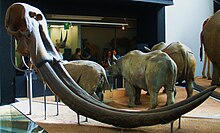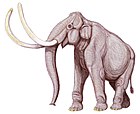劍齒象屬:修订间差异
无编辑摘要 |
內容擴充 |
||
| 第27行: | 第27行: | ||
'''剑齿象屬'''(學名:''Stegodon''),已灭绝的[[哺乳动物]],为[[剑齿象科]]的一个属。它们生活在距今1160万-11,000年前,地理分布仅限于[[亚洲]]和[[非洲]]的部分地区。 |
'''剑齿象屬'''(學名:''Stegodon''),已灭绝的[[哺乳动物]],为[[剑齿象科]]的一个属。它们生活在距今1160万-11,000年前,地理分布仅限于[[亚洲]]和[[非洲]]的部分地区。 |
||
== |
==形態學== |
||
| ⚫ | |||
| ⚫ | |||
[[File:ExtinctElephant-SiwalikHills.JPG|thumb|left|剑齿象复原模型]] |
[[File:ExtinctElephant-SiwalikHills.JPG|thumb|left|剑齿象复原模型]] |
||
| ⚫ | |||
头骨、腿比[[亚洲象]]和[[非洲象]]长,上[[颌]]的象牙又长又大且向上弯曲,下颌比较短,没有象牙。 |
|||
劍齒象屬包含了部分長鼻目中體型最大的物種,其中於[[黃河]]出土的師氏劍齒象(''S. zdansky'')化石,屬於老年雄性個體(超過50歲),肩高達{{cvt|3.87|m|ft}}、[[肱骨]]長{{cvt|1.21|m|ft}}、[[股骨]]長{{cvt|1.46|m|ft}}、[[骨盆]]寬度達{{cvt|2|m|ft}}<ref name="proboscideans">{{Cite journal | last1 = Larramendi | first1 = A. | year = 2016 | title = Shoulder height, body mass and shape of proboscideans | journal = Acta Palaeontologica Polonica | volume = 61 | doi = 10.4202/app.00136.2014 | s2cid = 2092950 | url = https://www.app.pan.pl/archive/published/app61/app001362014.pdf | doi-access = free }}</ref>、體重估計可達{{convert|12.7|t|LT ST}}。除了師氏劍齒象(''S. zdansky'')外,其他物種如 華麗劍齒象(''S. ganesha'')、三重劍齒象(''S. miensis'')、東方劍齒象(''S. orientalis'')、類象劍齒象(''S. elephantoides'')、顯明劍齒象(''S. insignis'')與凱氏劍齒象(''S. kaisensis''),體型也都與現存[[象]]體型近似。這些大體型的劍齒象主要棲居於大陸,而棲居於島嶼的曙光劍齒象(''S. aurorae'')、三角頭劍齒象(''S. trigonocephalus'')與大弗洛勒斯倭劍齒象(''S. florensis florensis'')體型則有侏儒化的趨勢。 |
|||
===侏儒化=== |
|||
和現存的大象一樣,劍齒象同樣擁有很好的游泳能力<ref>Simpson, G. (1977). Too Many Lines; The Limits of the Oriental and Australian Zoogeographic Regions. Proceedings of the American Philosophical Society, 121(2), 107-120. Retrieved from http://www.jstor.org/stable/986523</ref><ref>{{cite journal | last1=Bird | first1=Michael I. | last2=Condie | first2=Scott A. | last3=O’Connor | first3=Sue | last4=O’Grady | first4=Damien | last5=Reepmeyer | first5=Christian | last6=Ulm | first6=Sean | last7=Zega | first7=Mojca | last8=Saltré | first8=Frédérik | last9=Bradshaw | first9=Corey J. A. | title=Early human settlement of Sahul was not an accident | journal=Scientific Reports | volume=9 | issue=1 | pages=8220 | pmid=31209234 | doi=10.1038/s41598-019-42946-9 | pmc=6579762 | year=2019 }}</ref>,也因此牠們的化石可以在許多亞洲地區的島嶼上發現,例如[[印尼]]的[[蘇拉威西島]]、[[弗洛勒斯島]]、[[帝汶]]、[[松巴島]];[[菲律賓]]的[[呂宋]]、[[民答那峨島]];[[台灣]]以及[[日本]],其中有部分島嶼即使在更新世冰河期水位較低時也沒有與亞洲大陸形成[[陸橋說|陸橋]]連結,且許多棲息於島嶼上的劍齒象有[[島嶼侏儒化]]的趨勢。目前已知體型最小的劍齒象為松巴島的松巴劍齒象(''S. sumbaensis'')<ref>{{Cite journal|last1=Turvey|first1=Samuel T.|last2=Crees|first2=Jennifer J.|last3=Hansford|first3=James|last4=Jeffree|first4=Timothy E.|last5=Crumpton|first5=Nick|last6=Kurniawan|first6=Iwan|last7=Setiyabudi|first7=Erick|last8=Guillerme|first8=Thomas|last9=Paranggarimu|first9=Umbu|last10=Dosseto|first10=Anthony|last11=van den Bergh|first11=Gerrit D.|date=2017-08-30|title=Quaternary vertebrate faunas from Sumba, Indonesia: implications for Wallacean biogeography and evolution|journal=Proceedings of the Royal Society B: Biological Sciences|volume=284|issue=1861|pages=20171278|doi=10.1098/rspb.2017.1278|pmc=5577490|pmid=28855367}}</ref>,體重約僅有{{convert|250|kg}}<ref name=":1">{{Cite journal|last1=van der Geer|first1=Alexandra A. E.|last2=van den Bergh|first2=Gerrit D.|last3=Lyras|first3=George A.|last4=Prasetyo|first4=Unggul W.|last5=Due|first5=Rokus Awe|last6=Setiyabudi|first6=Erick|last7=Drinia|first7=Hara|date=2016|title=The effect of area and isolation on insular dwarf proboscideans|journal=[[Journal of Biogeography]]|language=en|volume=43|issue=8|pages=1656–1666|doi=10.1111/jbi.12743|url=https://ro.uow.edu.au/cgi/viewcontent.cgi?article=5039&context=smhpapers}}</ref>。體型稍大的小弗洛勒斯倭劍齒象(''S. sondaari''),發現於印尼弗洛勒斯島更新世早期的地層,體重約為{{convert|355|-|650|kg}}<ref name=":1"/>;另外一項估計肩高為{{cvt|1.2|m|ft}},體重約為{{cvt|350|-|400|kg}}<ref name="proboscideans"/>。棲息於菲律賓的劍齒象(''S. luzonensis''與''S. mindanensis'')也具有與小弗洛勒斯倭劍齒象(''S. sondaari'')和蘇拉威西倭劍齒象(''S. sompoensis'')近似的體型<ref>{{Cite journal|last=Hooijer|first=D.A.|date=1974|title=Quaternary Mammals West and East of Wallace’s Line|journal=Netherlands Journal of Zoology|volume=25|pages=46–56|doi=10.1163/002829675x00128 }}</ref>,其中民答那峨劍齒象(''S. mindanensis'')的體重約為{{cvt|400|kg}}<ref>{{Cite book|last=Ong|first=Perry|url=https://www.researchgate.net/publication/303496589_The_Philippine_menagerie|title=The Philippine Archipelago|publisher=Asia Publishing Co. Ltd.|year=1998|location=Makati city, Philippines|pages=227-255|chapter=The Philippine Menagerie}}</ref>。在850,000年前[[印尼]][[弗洛勒斯島]]上,棲息著體型較大的大弗洛勒斯倭劍齒象(''S. florensis''),體重約為{{cvt|1700|kg}};在這之後大弗洛勒斯倭劍齒象演化成體型較小的島嶼劍齒象(''S. florensis insularis''),體重約為{{cvt|570|kg}}<ref name=":1"/><ref name=":0">Van Den Bergh, G.D., Aweb, R.D., Morwoodc, M.J., Sutiknab, T., Jatmikob and Saptomo, E. W. 2008. The youngest stegodon remains in Southeast Asia from the Late Pleistocene archaeological site Liang Bua, Flores, Indonesia. Quaternary International 182(1): 16-48.</ref>(但另一項估計肩高為{{cvt|2|m|ft}},體重約為{{cvt|2|t|LT ST}}<ref name="proboscideans"/>);牠們的化石可以在島上的{{link-en|梁布亞岩洞|Liang Bua}}發現。島嶼劍齒象被同時代的[[人族]][[佛羅勒斯人]]狩獵,而這些佛羅勒斯人約於49,600年滅絕<ref>{{Cite journal|last1=Sutikna|first1=Thomas|last2=Tocheri|first2=Matthew W.|last3=Morwood|first3=Michael J.|last4=Saptomo|first4=E. Wahyu|last5=Jatmiko|last6=Awe|first6=Rokus Due|last7=Wasisto|first7=Sri|last8=Westaway|first8=Kira E.|last9=Aubert|first9=Maxime|last10=Li|first10=Bo|last11=Zhao|first11=Jian-xin|date=April 2016|title=Revised stratigraphy and chronology for Homo floresiensis at Liang Bua in Indonesia|url=http://www.nature.com/articles/nature17179|journal=Nature|language=en|volume=532|issue=7599|pages=366–369|doi=10.1038/nature17179|pmid=27027286|s2cid=4469009|issn=0028-0836}}</ref>,略早於之前所作的估計值<ref name="Van Den Bergh">{{cite journal | last = Van Den Bergh | first = G. D. |author2=Rokhus Due Awe |author3=Morwood, M. J. |author4=Sutikna, T. |author5=Jatmiko |author6= Wahyu Saptomo, E. | title = The youngest ''Stegodon'' remains in Southeast Asia from the Late Pleistocene archaeological site Liang Bua, Flores, Indonesia | journal = [[Quaternary International]] | volume = 182 | issue = 1 | pages = 16–48 | date = May 2008 | doi = 10.1016/j.quaint.2007.02.001 |bibcode = 2008QuInt.182...16V }}</ref>。這些體型較小的劍齒象也被認為是{{link-en|演化時代錯位|Evolutionary anachronism|現今仍存在的}}[[科莫多龍]]的主要獵物,直到人類來到這些島嶼並帶來了[[馬來豬]]、[[鬣鹿]]及[[水牛]]<ref>Diamond, Jared M. (1987). "Did Komodo dragons evolve to eat pygmy elephants?". Nature. 326 (6116): 832.</ref>。 |
|||
[[File:Stegodon aurorae and Stegodon orientalis.jpg|thumb|日本东京[[国立科学博物馆]]的曙光劍齒象 (左)和東方劍齒象 (右)化石。]] |
[[File:Stegodon aurorae and Stegodon orientalis.jpg|thumb|日本东京[[国立科学博物馆]]的曙光劍齒象 (左)和東方劍齒象 (右)化石。]] |
||
[[File:Stegodon ganesa.JPG|thumb|華麗劍齒象头骨]] |
[[File:Stegodon ganesa.JPG|thumb|華麗劍齒象头骨]] |
||
| ⚫ | |||
== 种类 == |
== 种类 == |
||
{| class="wikitable" |
{| class="wikitable" |
||
! 学名 !! 中文名 !! 出土地 |
! 学名 !! 中文名 !! 出土地 |
||
| 第49行: | 第52行: | ||
| {{snamei|Stegodon ganesha}} || 华丽剑齿象 || [[印度]] |
| {{snamei|Stegodon ganesha}} || 华丽剑齿象 || [[印度]] |
||
|- |
|- |
||
| {{snamei|Stegodon kaisensis}} || || |
| {{snamei|Stegodon kaisensis}} || 凱氏劍齒象 || |
||
|- |
|- |
||
| {{snamei|Stegodon luzonensis}} ||呂宋劍齒象 || [[菲律宾]] |
| {{snamei|Stegodon luzonensis}} ||呂宋劍齒象 || [[菲律宾]] |
||
|- |
|- |
||
| {{snamei|Stegodon |
| {{snamei|Stegodon miensis}} ||三重劍齒象 || 日本、台灣 |
||
|- |
|- |
||
| {{snamei|Stegodon mindanensis}} ||民答那峨劍齒象 || 菲律宾 |
| {{snamei|Stegodon mindanensis}} ||民答那峨劍齒象 || 菲律宾 |
||
|- |
|- |
||
| {{snamei|Stegodon orientalis}} || |
| {{snamei|Stegodon orientalis}} || 东方剑齿象 || [[中華人民共和国|中国]]、[[日本]]、[[台灣]] |
||
|- |
|- |
||
| {{snamei|Stegodon sompoensis}} ||蘇拉威西倭劍齒象|| [[苏拉威西岛]] |
| {{snamei|Stegodon sompoensis}} ||蘇拉威西倭劍齒象|| [[苏拉威西岛]] |
||
| 第63行: | 第66行: | ||
| {{snamei|Stegodon sondaari}} ||小弗洛勒斯倭劍齒象|| 弗洛勒斯岛 |
| {{snamei|Stegodon sondaari}} ||小弗洛勒斯倭劍齒象|| 弗洛勒斯岛 |
||
|- |
|- |
||
| {{snamei|Stegodon |
| {{snamei|Stegodon sumbaensis}} || 松巴劍齒象 || 松巴島 |
||
|- |
|||
| {{snamei|Stegodon trigonocephalus}} || 三角头剑齿象 || 爪哇岛 |
|||
|- |
|- |
||
| {{snamei|Stegodon zdanski}} || [[师氏剑齿象]](黄河象) || 中国 |
| {{snamei|Stegodon zdanski}} || [[师氏剑齿象]](黄河象) || 中国 |
||
|- |
|- |
||
| {{snamei|Stegodon insignis}} || |
| {{snamei|Stegodon insignis}} || 顯明劍齒象|| [[印度]]、[[台灣]] |
||
|} |
|} |
||
| 第91行: | 第96行: | ||
}} |
}} |
||
}} |
}} |
||
== 形態 == |
|||
剑齿象至肩膀有4米,8米长。一些剑齿象是[[长鼻目]]中最大的品種。 |
|||
==参考== |
==参考== |
||
2021年7月4日 (日) 11:51的版本
| 劍齒象屬 | |
|---|---|

| |
絕滅(公元前2150年)
| |
| 科学分类 | |
| 界: | 动物界 Animalia |
| 门: | 脊索动物门 Chordata |
| 纲: | 哺乳纲 Mammalia |
| 目: | 长鼻目 Proboscidea |
| 科: | †劍齒象科 Stegodontidae |
| 属: | †劍齒象屬 Stegodon Falconer, 1847 |
| 種 | |
| |
剑齿象屬(學名:Stegodon),已灭绝的哺乳动物,为剑齿象科的一个属。它们生活在距今1160万-11,000年前,地理分布仅限于亚洲和非洲的部分地区。
形態學


體型
劍齒象屬包含了部分長鼻目中體型最大的物種,其中於黃河出土的師氏劍齒象(S. zdansky)化石,屬於老年雄性個體(超過50歲),肩高達3.87米(12.7英尺)、肱骨長1.21米(4.0英尺)、股骨長1.46米(4.8英尺)、骨盆寬度達2米(6.6英尺)[1]、體重估計可達12.7公噸(12.5長噸;14.0短噸)。除了師氏劍齒象(S. zdansky)外,其他物種如 華麗劍齒象(S. ganesha)、三重劍齒象(S. miensis)、東方劍齒象(S. orientalis)、類象劍齒象(S. elephantoides)、顯明劍齒象(S. insignis)與凱氏劍齒象(S. kaisensis),體型也都與現存象體型近似。這些大體型的劍齒象主要棲居於大陸,而棲居於島嶼的曙光劍齒象(S. aurorae)、三角頭劍齒象(S. trigonocephalus)與大弗洛勒斯倭劍齒象(S. florensis florensis)體型則有侏儒化的趨勢。
侏儒化
和現存的大象一樣,劍齒象同樣擁有很好的游泳能力[2][3],也因此牠們的化石可以在許多亞洲地區的島嶼上發現,例如印尼的蘇拉威西島、弗洛勒斯島、帝汶、松巴島;菲律賓的呂宋、民答那峨島;台灣以及日本,其中有部分島嶼即使在更新世冰河期水位較低時也沒有與亞洲大陸形成陸橋連結,且許多棲息於島嶼上的劍齒象有島嶼侏儒化的趨勢。目前已知體型最小的劍齒象為松巴島的松巴劍齒象(S. sumbaensis)[4],體重約僅有250公斤(550英磅)[5]。體型稍大的小弗洛勒斯倭劍齒象(S. sondaari),發現於印尼弗洛勒斯島更新世早期的地層,體重約為355—650公斤(783—1,433英磅)[5];另外一項估計肩高為1.2米(3.9英尺),體重約為350—400公斤(770—880磅)[1]。棲息於菲律賓的劍齒象(S. luzonensis與S. mindanensis)也具有與小弗洛勒斯倭劍齒象(S. sondaari)和蘇拉威西倭劍齒象(S. sompoensis)近似的體型[6],其中民答那峨劍齒象(S. mindanensis)的體重約為400公斤(880磅)[7]。在850,000年前印尼弗洛勒斯島上,棲息著體型較大的大弗洛勒斯倭劍齒象(S. florensis),體重約為1,700公斤(3,700磅);在這之後大弗洛勒斯倭劍齒象演化成體型較小的島嶼劍齒象(S. florensis insularis),體重約為570公斤(1,260磅)[5][8](但另一項估計肩高為2米(6.6英尺),體重約為2 t(2.0 long ton;2.2 short ton)[1]);牠們的化石可以在島上的梁布亞岩洞發現。島嶼劍齒象被同時代的人族佛羅勒斯人狩獵,而這些佛羅勒斯人約於49,600年滅絕[9],略早於之前所作的估計值[10]。這些體型較小的劍齒象也被認為是現今仍存在的科莫多龍的主要獵物,直到人類來到這些島嶼並帶來了馬來豬、鬣鹿及水牛[11]。


种类
| 学名 | 中文名 | 出土地 |
|---|---|---|
| Stegodon aurorae | 曙光劍齒象 | 日本、台灣 |
| Stegodon elephantoides | 类象剑齿象 | 缅甸、爪哇岛、台灣 |
| Stegodon florensis | 大弗洛勒斯倭劍齒象 | 弗洛勒斯岛 |
| Stegodon ganesha | 华丽剑齿象 | 印度 |
| Stegodon kaisensis | 凱氏劍齒象 | |
| Stegodon luzonensis | 呂宋劍齒象 | 菲律宾 |
| Stegodon miensis | 三重劍齒象 | 日本、台灣 |
| Stegodon mindanensis | 民答那峨劍齒象 | 菲律宾 |
| Stegodon orientalis | 东方剑齿象 | 中国、日本、台灣 |
| Stegodon sompoensis | 蘇拉威西倭劍齒象 | 苏拉威西岛 |
| Stegodon sondaari | 小弗洛勒斯倭劍齒象 | 弗洛勒斯岛 |
| Stegodon sumbaensis | 松巴劍齒象 | 松巴島 |
| Stegodon trigonocephalus | 三角头剑齿象 | 爪哇岛 |
| Stegodon zdanski | 师氏剑齿象(黄河象) | 中国 |
| Stegodon insignis | 顯明劍齒象 | 印度、台灣 |
种系发展
| ||||||||||||||||||||||||||||||||||
参考
- ^ 1.0 1.1 1.2 Larramendi, A. Shoulder height, body mass and shape of proboscideans (PDF). Acta Palaeontologica Polonica. 2016, 61. S2CID 2092950. doi:10.4202/app.00136.2014
 .
.
- ^ Simpson, G. (1977). Too Many Lines; The Limits of the Oriental and Australian Zoogeographic Regions. Proceedings of the American Philosophical Society, 121(2), 107-120. Retrieved from http://www.jstor.org/stable/986523
- ^ Bird, Michael I.; Condie, Scott A.; O’Connor, Sue; O’Grady, Damien; Reepmeyer, Christian; Ulm, Sean; Zega, Mojca; Saltré, Frédérik; Bradshaw, Corey J. A. Early human settlement of Sahul was not an accident. Scientific Reports. 2019, 9 (1): 8220. PMC 6579762
 . PMID 31209234. doi:10.1038/s41598-019-42946-9.
. PMID 31209234. doi:10.1038/s41598-019-42946-9.
- ^ Turvey, Samuel T.; Crees, Jennifer J.; Hansford, James; Jeffree, Timothy E.; Crumpton, Nick; Kurniawan, Iwan; Setiyabudi, Erick; Guillerme, Thomas; Paranggarimu, Umbu; Dosseto, Anthony; van den Bergh, Gerrit D. Quaternary vertebrate faunas from Sumba, Indonesia: implications for Wallacean biogeography and evolution. Proceedings of the Royal Society B: Biological Sciences. 2017-08-30, 284 (1861): 20171278. PMC 5577490
 . PMID 28855367. doi:10.1098/rspb.2017.1278.
. PMID 28855367. doi:10.1098/rspb.2017.1278.
- ^ 5.0 5.1 5.2 van der Geer, Alexandra A. E.; van den Bergh, Gerrit D.; Lyras, George A.; Prasetyo, Unggul W.; Due, Rokus Awe; Setiyabudi, Erick; Drinia, Hara. The effect of area and isolation on insular dwarf proboscideans. Journal of Biogeography. 2016, 43 (8): 1656–1666. doi:10.1111/jbi.12743 (英语).
- ^ Hooijer, D.A. Quaternary Mammals West and East of Wallace’s Line. Netherlands Journal of Zoology. 1974, 25: 46–56. doi:10.1163/002829675x00128 .
- ^ Ong, Perry. The Philippine Menagerie. The Philippine Archipelago. Makati city, Philippines: Asia Publishing Co. Ltd. 1998: 227–255.
- ^ Van Den Bergh, G.D., Aweb, R.D., Morwoodc, M.J., Sutiknab, T., Jatmikob and Saptomo, E. W. 2008. The youngest stegodon remains in Southeast Asia from the Late Pleistocene archaeological site Liang Bua, Flores, Indonesia. Quaternary International 182(1): 16-48.
- ^ Sutikna, Thomas; Tocheri, Matthew W.; Morwood, Michael J.; Saptomo, E. Wahyu; Jatmiko; Awe, Rokus Due; Wasisto, Sri; Westaway, Kira E.; Aubert, Maxime; Li, Bo; Zhao, Jian-xin. Revised stratigraphy and chronology for Homo floresiensis at Liang Bua in Indonesia. Nature. April 2016, 532 (7599): 366–369. ISSN 0028-0836. PMID 27027286. S2CID 4469009. doi:10.1038/nature17179 (英语).
- ^ Van Den Bergh, G. D.; Rokhus Due Awe; Morwood, M. J.; Sutikna, T.; Jatmiko; Wahyu Saptomo, E. The youngest Stegodon remains in Southeast Asia from the Late Pleistocene archaeological site Liang Bua, Flores, Indonesia. Quaternary International. May 2008, 182 (1): 16–48. Bibcode:2008QuInt.182...16V. doi:10.1016/j.quaint.2007.02.001.
- ^ Diamond, Jared M. (1987). "Did Komodo dragons evolve to eat pygmy elephants?". Nature. 326 (6116): 832.
| ||||||||||||||||||||||||||||||||||||||||||||||||||||||||||||||||||||||||||||||||||||||||||||||||||||||||||||||||||||||
|




